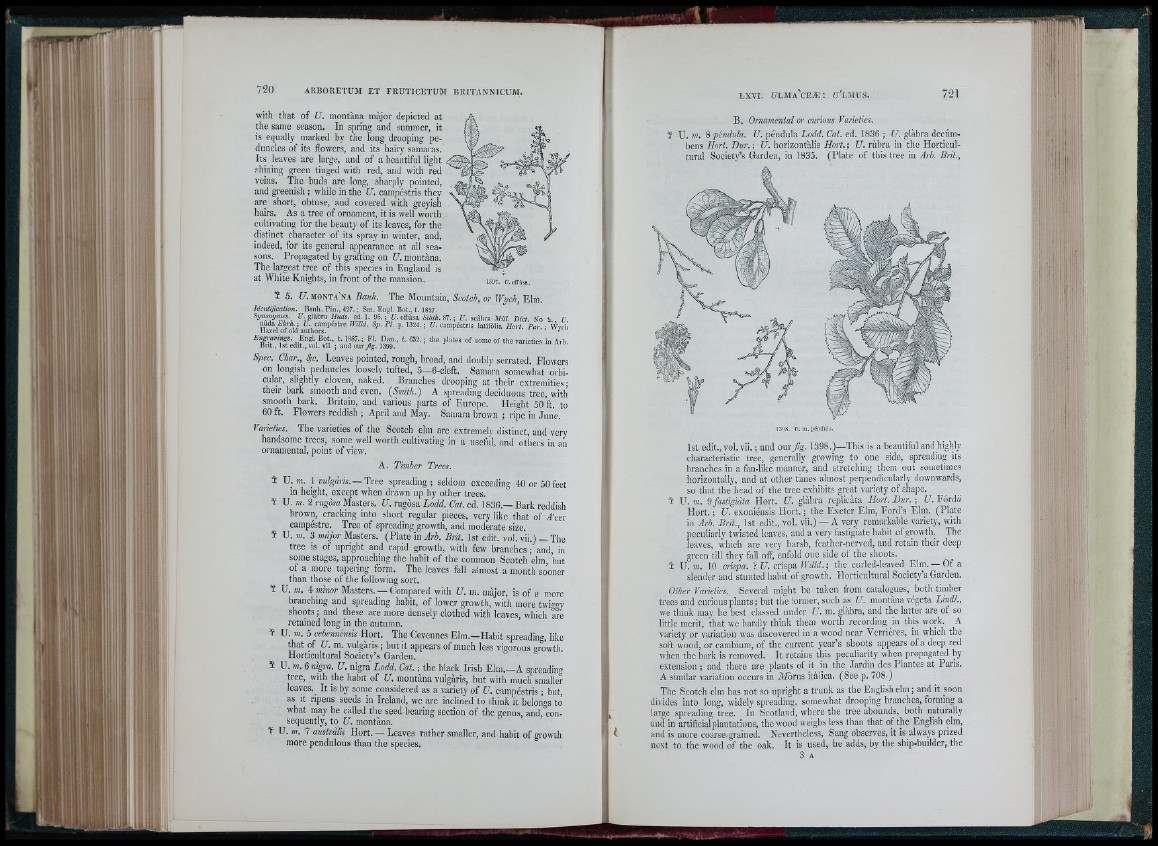
i . i;
with that of 27. montàna màjor depicted at
the same season. In spring and summer, it
is equally marked by the long drooping peduncles
of its flowers, and its hairy samaras.
Its leaves are large, and of a beautiful light
shining green tinged with red, and with red
veins. The buds are long, sharply pointed,
and greenish ; while in the U. campéstris they
are short, obtuse, and covered with greyish
hairs. As a tree of ornament, it is well worth
cultivating for the beauty of its leaves, for the
distinct character of its spray in winter, and,
indeed, for its general appearance at all seasons.
Propagated by grafting on 27. montàna.
The largest tree of this species in England is
at White Knights, in front of the mansion.
¥ 5. 27. m o n t a 'n a Bauh. The Mountain, Scotch, or Wych, Elm.
Identification. Baiih. Pin., 427. ; Sm. Engl. Bot., t. 1827.
Synonynies. I/, glàbra Hvdt. ed. 1. 96. ; U. eflùsa Sibth. 87. ; U. scàbra Mül Diet. No 9 7;
H a r e l^ t t a j a u th S i" " '•'«'f'»'» Nari. Par. ; \Ìych
/ g l EÓt., l. 1887.; FI. Dan., t. 832.; the plates of some of the varieties in Arb.
lin t., 1st edit., vol. vn. ; and o u r / ^ . 1399.
free. Char., f r . Leaves pointed, rough, broad, and doubly serrated. Flowers
on longish peduncles loosely tufted, 5—6-cleft. Samara somewhat orbicular,
slightly cloven, naked. Branches drooping at their extremities;
their bark smooth and even. (Smith.) A spreading deciduous tree, with
smooth bark. Britain, and various parts of Europe. Height SO ft to
60 ft. Flowers reddish ; April and May. Samara brown ; ripe in June.
Varieties. The varieties of the Scotch elm are extremelj’ distinct, and very
handsome trees, some well worth cultivating in a useful, and others in an
ornamental, point of view.
A. Timber Trees.
¥ U. JM. \ vulgaris.— Tree spreading; seldom exceeding 40 or 50feet
in height, except when drawn up by other trees.
t U. m. 2 rugósa Masters. U. rugósa Lodd. Cat. ed. 1836.— Bark reddi.sh
brown, cracking into short regular pieces, very like that of A'cer
campèstre. Tree of spreading growth, and moderate size.
¥ U. m. 3 major Masters. (Plate in Arb. Bril. 1st edit. vol. vii.) The
tree is of upright and rapid growth, with few branches ,• and, in
some stages, approaching tbe habit of the common Scotch elm, but
of a more tapering form. The leaves fall almost a month sooner
than those of the following sort.
¥ U. V l . 4 minor Masters. — Compared with 27. m. major, is of a more
branching and spreading habit, of lower growth, with more twjfigy
shoots ; and these are more densely clothed with leaves, which are
retained long in the autumn.
¥ U. m. 5 cebennénsis Hort. The Cevennes Elm.—Habit spreading, like
that of 27. m, vulgàris ; but it appeal’s of much less vigorous ^roVth.
Horticultural Society’s Garden. °
¥ IJ. JH. 6 n^ra. 27. nigra Lodd. Cat, ; the black Irish Elm.—A spreading
tree, with the habit of 27. montàna vulgaris, but with much smaller
leaves. It is by some considered as a variety of U. campéstris ; but,
as it ripens seeds in Irelànd, we are inclined to think it belongs to
what may be called the seed-bearing section of the genus, and, consequently,
to 27. montàna.
¥ Ü. m. 7 austràlis Hort. — Leaves rather smaller, and habit of growth
more pendulous than the species.
B. Ornamental or curious Varieties.
¥ XJ. m. 8 péndula. 27. péndula Lodd. Cat. ed. 1836 ; 27. glabra decûmbens
Hurt. Dur.-, 27. horizontàlis Hort.-, 27. rubra in the Horticultural
Society’s Garden, in 1835. (Plate of this tree in Arb. Brit., 'Üüïi,
1st edit., vol. vii. ; and our Jig. 1398.)—This is a beautiful and highly
characteristic tree, generally growing to one side, spreading its
branches in a fan-like manner, and stretching them out sometimes
horizontally, and at other times almost perpendicularly downwards,
so that the head of the tree exhibits great variety of shape.
¥ U. m. 9 fastigiàta Hort. 27. glabra replicata Hort. Dur. ; 27. Fórd¿¿
Hort. ; 27. exoniénsis Hort. ; the Exeter Elm, Ford’s Ehn. (Plate
in Arb. Brit., 1st edit., vol. vii.) — A very remarkable variety, with
peculiarly twisted leaves, and a very fastigiate habit of growth. The
leaves, which are very harsh, feather-nerved, and retain their deep
green till they fall off, enfold one side of the shoots.
¥ U. m. 10 ciispa. ? 27. crispa Wilid.; the curled-leaved Elm.— Of a
slender and stunted habit of growth. Horticultural Society’s Garden.
Other Varieties. Several might be taken from catalogues, both timber
trees and curious plants ; but the former, such as 27. montàna vegeta Lindi.,
we think may be best classed under 27. m. glàbra, and the latter are of so
little merit, that we hardly think them worth recording yn this work. A
variety or variation was discovered in a wood near Verrieres, in which the
soft wood, or cambium, of the current year’s shoots appears of a deep red
when the bark is removed. It retains this peculiarity when propagated by
extension ; and there are plants of it in the Jardin des Plantes at Paris.
A similar variation occurs in iffòrus itàlica. (See p. 708.)
The Scotch ehn has not so upright a trunk as the English elm ; and it soon
divides into long, widely spreading, somewhat drooping branches, forming a
large spreading tree. In Scotland, where the tree abounds, botli naturally
and in artificial plantations, the wood weighs less than that of the English elm,
and is more coarse-grained. Nevertheless, Sang observes, it is always prized
next to the wood of the oak. It is used, he adds, by the ship-builder, the
3 A